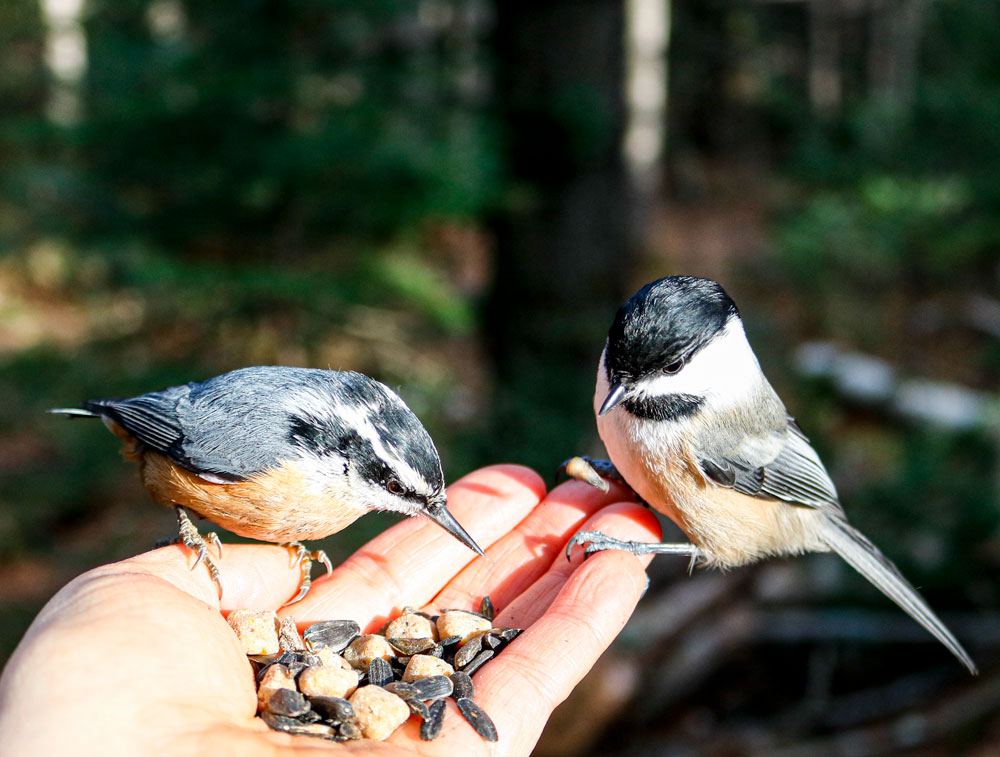
As an avid bird watcher and someone who spends a great deal of time outdoors, it was only natural that I would personally meet a few birds along the way. Over the several years that I have been feeding the birds with a variety of feeders, I have been fortunate enough to have many close encounters with my avian visitors. For years now, while refilling my feeders, I have had a black-capped chickadee or two, land on my hand, arm, or shoulder. This past fall, I began hand-feeding the birds and it has now evolved into part of my daily routine. Being that I spend so much time outdoors, my experiences with hand-feeding have evolved quite naturally. In this post, I will share my extraordinary experiences and some information and tips for how you can hand-feed birds, too.
Is it Okay to Hand-Feed Wild Birds?
First, before we get into discussing helpful tips for hand-feeding wild birds, it is important to acknowledge that feeding any wild animals can be a controversial topic for individuals. It is a very important point to remember that we as humans, although mean well, can have the potential to cause more harm than good. The same goes for feeding wild birds. Hand-feeding for some can be viewed as potentially disruptive to their natural behavior. First, you should find out if it is legal to feed the birds in your area, especially in public areas this may cause undesired effects such as attracting other animals.
Second, I found this informative article on the Audubon Society site pertaining to this very subject, entitled “When It’s Okay (or Not) to Feed Birds.” Please take a few moments and read this and then answer these three questions accordingly before proceeding with feeding wild birds. It is now up to you if you decide to proceed or not.
My Daily Routine with Feeding the Birds
I spend a lot of time outdoors throughout the seasons, so naturally, I have seen a great deal of wildlife. Whether I’m doing things like gardening or photography, many of the birds will stop by for a visit. I’m very happy to live in this wonderful playground called Maine. I also have a great deal of property with many resident birds. As I mentioned above, this past fall, I started getting into hand-feeding the birds in the backyard. I began with the black-capped chickadees that were perching in the apple trees. Now if you know anything about these birds, you know that these birds are curious by nature and may approach humans, especially humans offering them food. I also had white-breasted nuthatches and red-breasted nuthatches that have shown an interest in feeding from my hand.
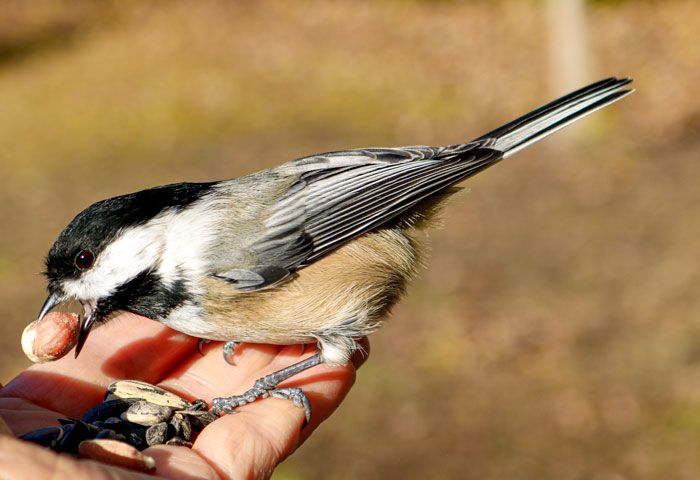
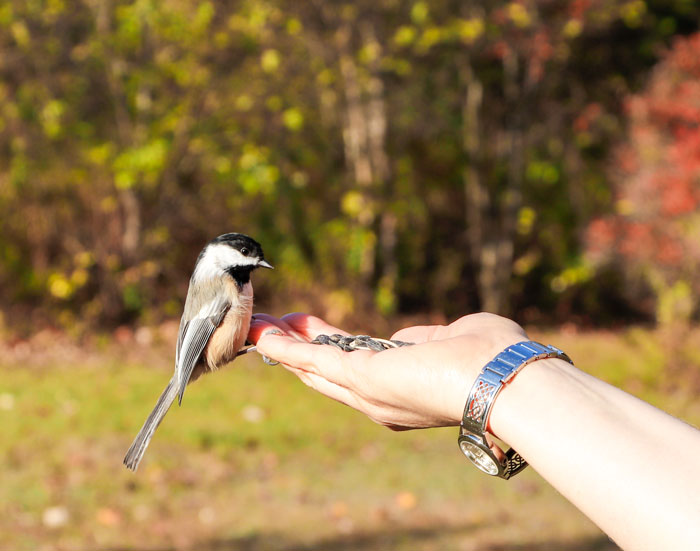

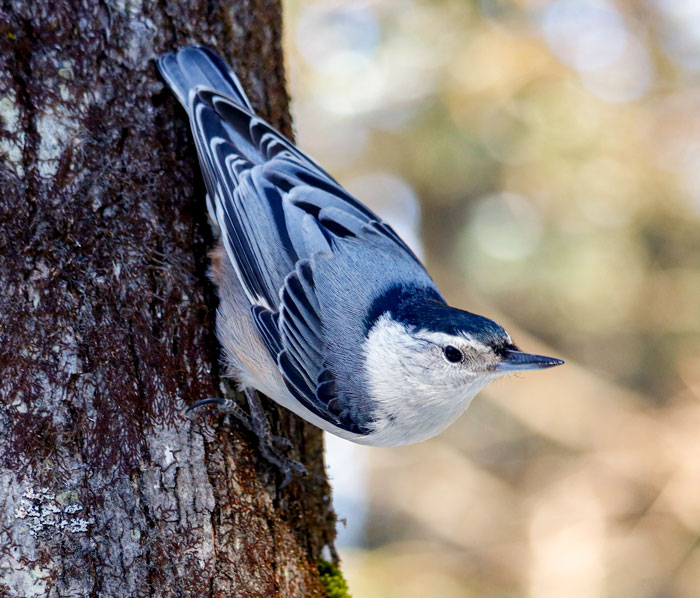
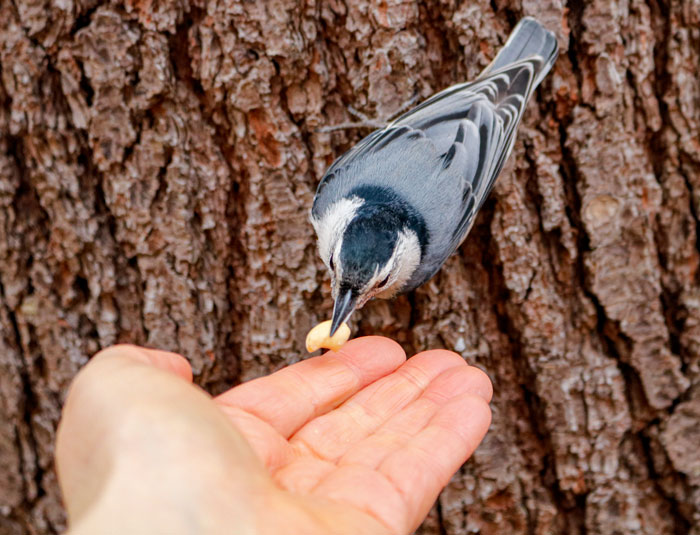
We now have a new routine. Every morning, rain or shine, my partner and I go for a nice walk through the backyard and back into the woods. Our routine includes bringing out our morning coffee in travel mugs and of course, food for the birds. I started out by bringing a small container of black sunflower seeds and peanut suet nuggets. Most recently, for my birthday, I received a sixteen-pound bag of Feathered Friend Chickadee’s Choice. This is a premium blend of bird food that attracts a variety of birds including chickadees, nuthatches, tufted titmice, juncos, and wrens. The mix includes sunflower kernels, tree nut pieces, peanuts, black oil sunflower, grey-striped sunflower, and safflower. I don’t know who was more excited, me or the birds. Every couple of days, I’ll add a small amount of this food to the black sunflower seeds. This food is a bit expensive, so I will have to make it last.

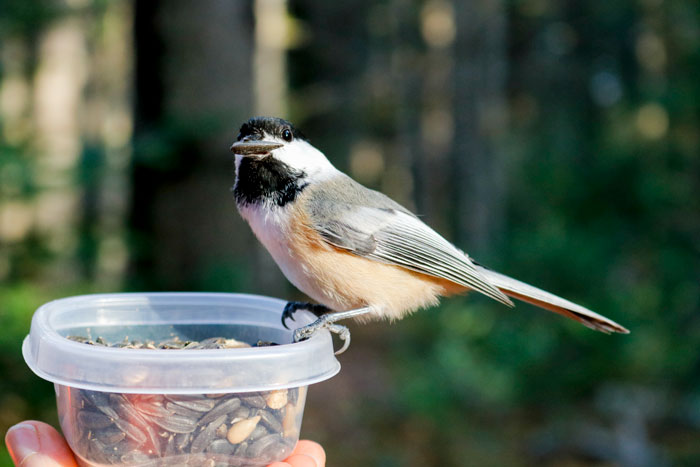
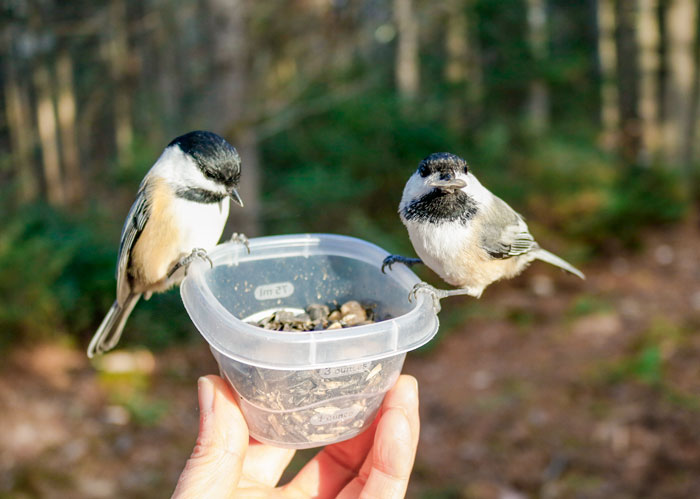
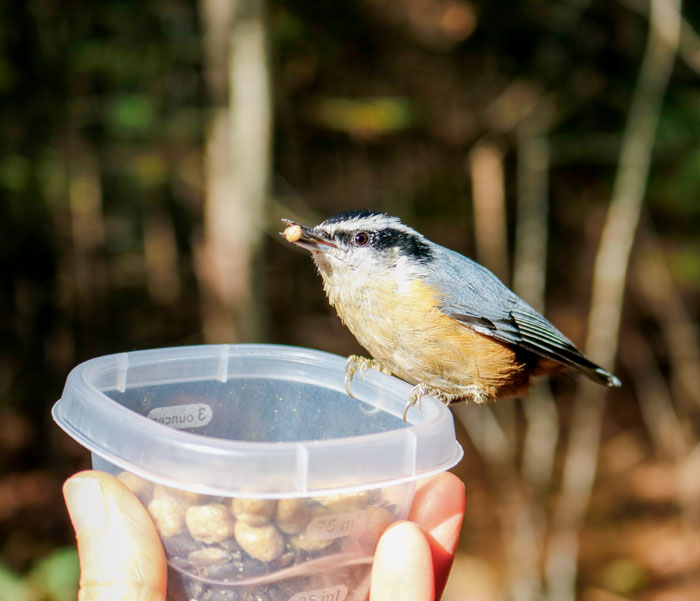
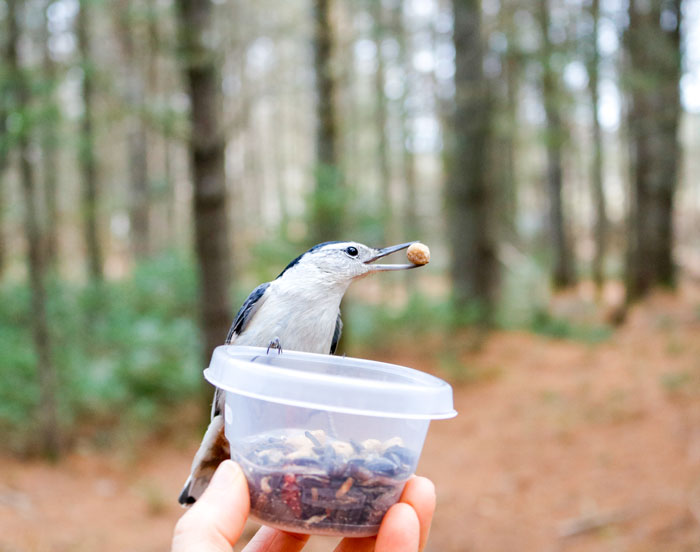
I now have an increasing amount of birds and have been carrying a much larger container. We usually spend about an hour or so outside with the birds and I found that I don’t run out of food as quickly with the larger container. I have also made a point of not offering the birds food in front of the house because I noticed they were following me up the driveway to the road. This is not the type of behavior I would like to promote, especially with the dangers for those involved with being out near the road. Also, I don’t want the birds approaching our visitors, the mailperson, or the UPS delivery person in the front of the house. I don’t want people to freak out and think they just arrived on the set of Hitchcock’s The Birds while being in the front yard. It is much safer in the backyard for my avian friends, so I always make a point of opening the food container in the back. On occasion, I will have a couple of chickadees greet me at the front door, but I won’t open the food container until we are in the back of the house.

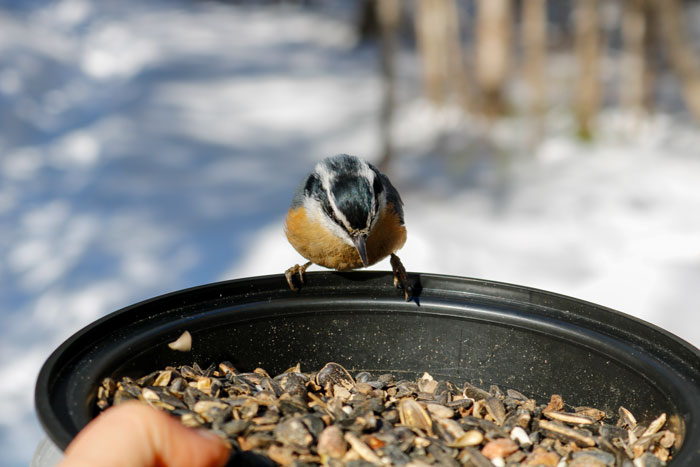
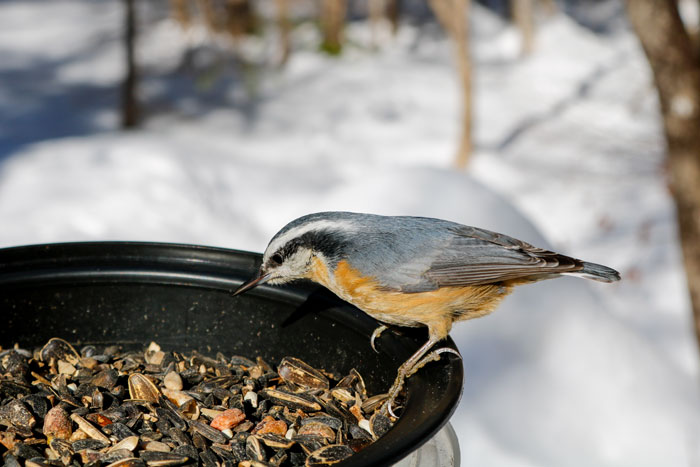
Did I mention, that the birds follow us around for our entire walk? I don’t know who else has experienced this, but it has become our new normal. With the addition of so many birds, the large container has helped to free up at least one of my hands. I carry the container in one hand and my coffee in the other. As we walk around the woods, the birds come and take what they want. If we stop to do something else, like take photographs or whatever, I simply put the container on the ground.
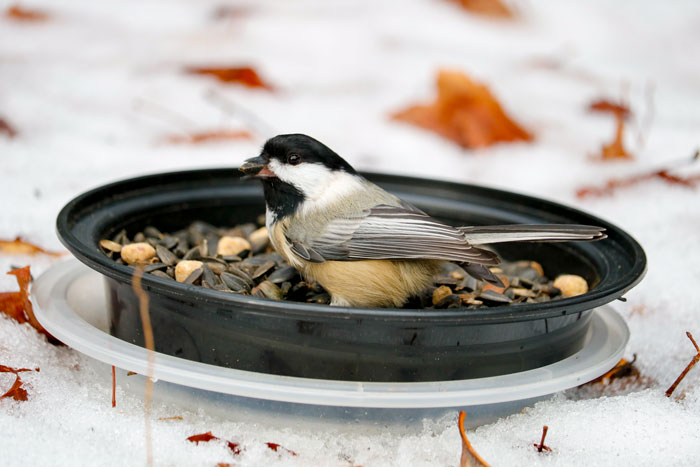
After doing this for months, I have gotten to know some of the birds pretty well along with their individual personalities and many quirks. As you can imagine, it can be quite difficult to tell the black-capped chickadees apart as well as their sexes. Chickadees are sexually monomorphic, meaning both sexes look nearly identical, except for their sexual organs. I noticed back in October, that I could tell which birds were females because I was able to spot their brood patches. This is a featherless area that females develop seasonally so that first their eggs and then secondly, their young can be warmed against the mother’s skin. There is one female in particular who has a small amount of white near her right eye, so I always know it is her. I think if she ever loses these white feathers, I will still know it is her because she usually takes two seeds every time she comes to me. The nuthatches have been quite comical, too. A few of them were a bit shyer at first, but they are now coming to visit me regularly. I can tell the sexes apart, being the males have darker-colored caps in both types of nuthatches. It has been a real joy getting to know these birds and believe me if I walk too fast, they all let me know and that I have to stop to make sure everyone gets a seed and leaves a satisfied customer. Believe me, no bird is left hungry.
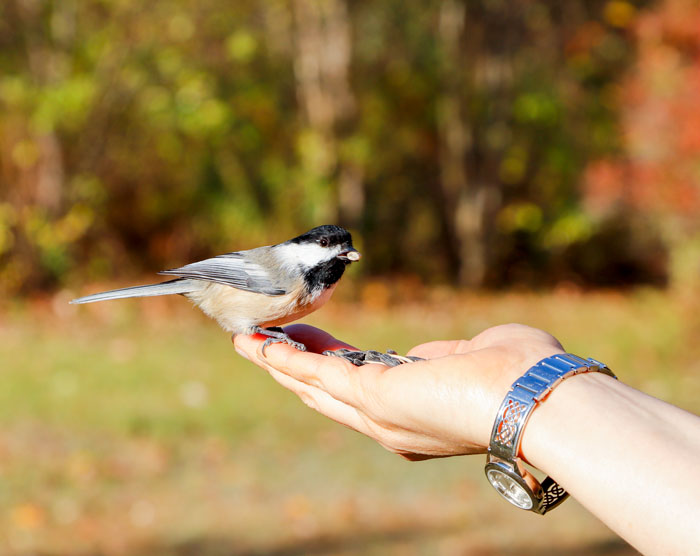
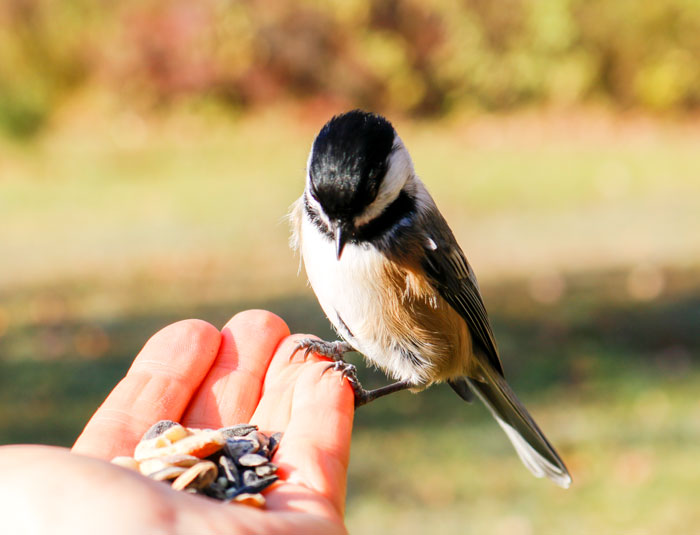
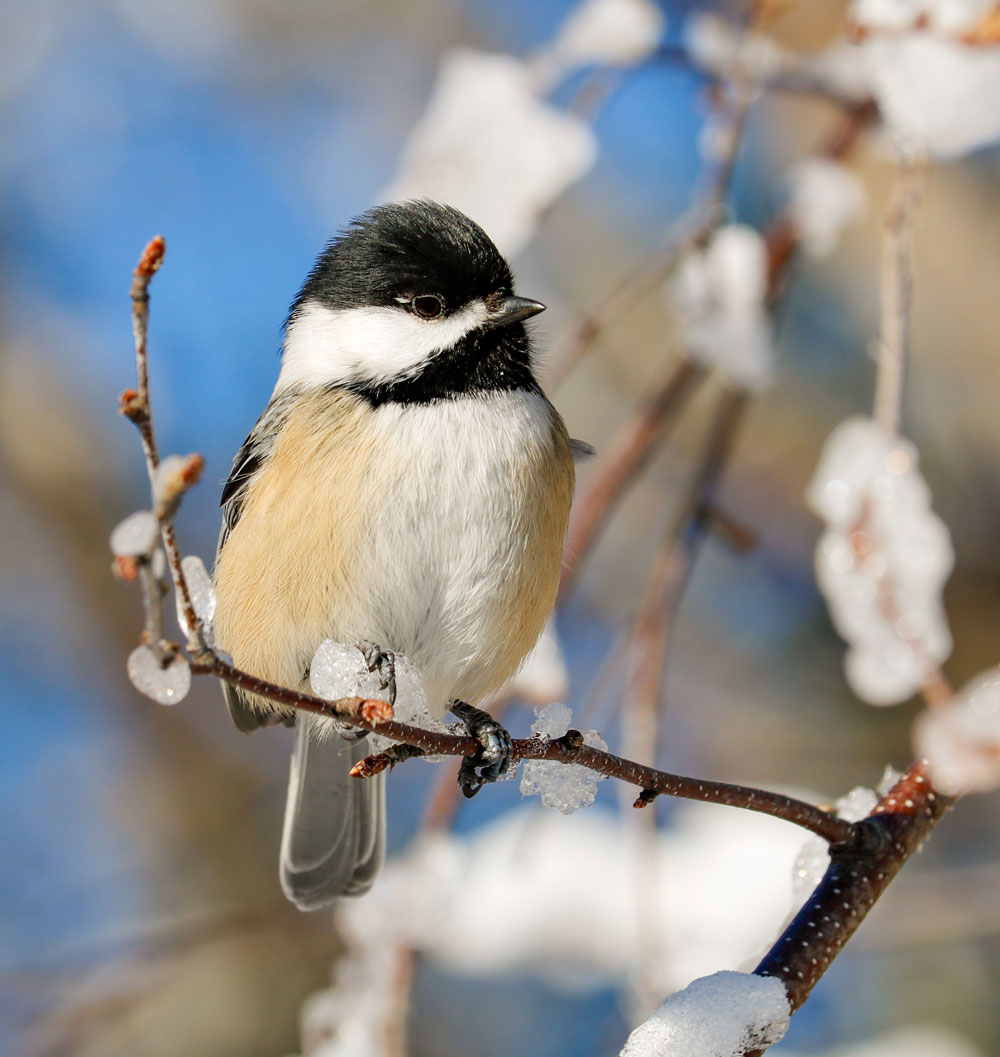
A Few Tips for Helping You to Hand-Feed Birds
These are a few helpful tips for you and your birds if you are starting from scratch with no prior experience with hand feeding. The best time of year to try feeding your birds is from the middle/late fall to early spring when the weather is on the cooler side and food sources are scarcer. I will have to see how things go but I have a feeling my birds by the middle of spring will be focusing on other things like breeding. Also, I think we will have fewer feeding sessions when there will be an abundance of insects available. It will be interesting to see if I will be able to hand-feed new bird species, such as the ruby-throated hummingbirds. I do have a couple of handheld nectar feeders and I will have to give these a try over the summer.
What Types of Birds Will Eat Out of Your Hand?
First, let’s find out what types of birds will eat from your hands once they get to know and trust you. Some of the more inquisitive, less timid, bird species that are easiest to attract, include the following: chickadees, nuthatches, tufted titmice, sparrows, redpolls, grosbeaks, downy woodpeckers, blue jays, goldfinches, bluebirds, and hummingbirds.
Create a Bird-Friendly Habitat
Having a variety of dense foliage with plenty of places for birds to perch and feel safe will help to create a welcoming environment. You can also plant trees that produce fruits and berry bushes as well as flowers and flowering bushes that appeal to a variety of birds. Also, you will want to provide a variety of feeders with different types of food. Here is some more information for further information on bird-friendly habitats.
Offer High-Quality Treats
Add some treats to your regular bird food such as peanuts, chopped walnuts, almonds, or pecans. This way, your birds will associate you with these treats and you will be on your way to successful hand-feeding sessions. Once you find that they become comfortable with you, you will use these treats to entice them into eating straight from your hand. Again, I can not recommend Chickadee’s Choice enough. My birds go crazy over this food and the birds will simply not be able to resist eating from your hand.
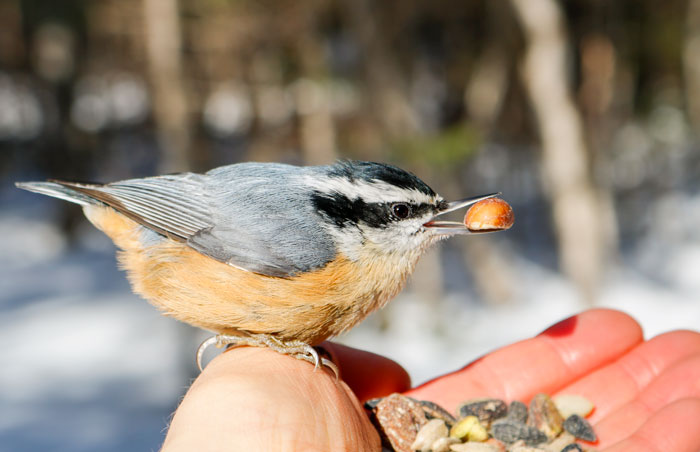
Introduce Yourself Gradually
Once the birds get used to seeing you while they are eating, stand a little closer to the bird feeder(s) each day and stay around as long as you can. You can stand at least ten to fifteen feet away at first a few times, then get slowly closer and stay as long as you can. At this point, you want to blend into the natural environment and you are not causing any stress to the birds. Keep as still as you can and avoid making any sudden movements or loud sounds.
Start to talk to Your New Bird Friends
Although you might feel silly talking to the birds, this will help in allowing the birds to further acclimate to you. Make sure to speak in a soft and relaxing tone. The more you do this, it will just come naturally.
Be Consistent
The more time you spend time in your yard, the better the birds will get to know you. As I mentioned above, I think this is why the birds have voluntarily landed on me or followed me around the yard. It is like some of us have become old friends at this point. I think that’s why I’ve had so many birds voluntarily land on me and let me come so close in the backyard and the woods. Also, make sure to never follow them, when they move or fly away, let them go. You don’t want to do anything that seems predatory in nature.
Start to Offer Your Hand
Once your birds become more comfortable with you standing nearby, while they are at the feeders, start holding your hand out while you watch them. After a few days in a row and the birds are used to eating near your hand, you are now ready to start feeding them yourself. When they are used to eating near you, place a few of their favorite treats in the palm of your hand.
Keep calm and still and wait for them to eat the treats from your hand. This can take some time, depending on the relationship you have established. If they don’t engage with you right away and get into your hand, don’t worry, after a few times of grabbing treats, they will start to become bolder and hop right into your hand.
Get ready for the experience. It will feel strange to have bird feet gripping onto your hands. Make sure not to jump, so you don’t startle them. I guarantee you, it is one of the most incredible experiences to feel these sweet little creatures gripping your skin.
Try to do this at the same time of day as birds have their own schedules. Your bird friends have places to go and other feeders to visit in the area.
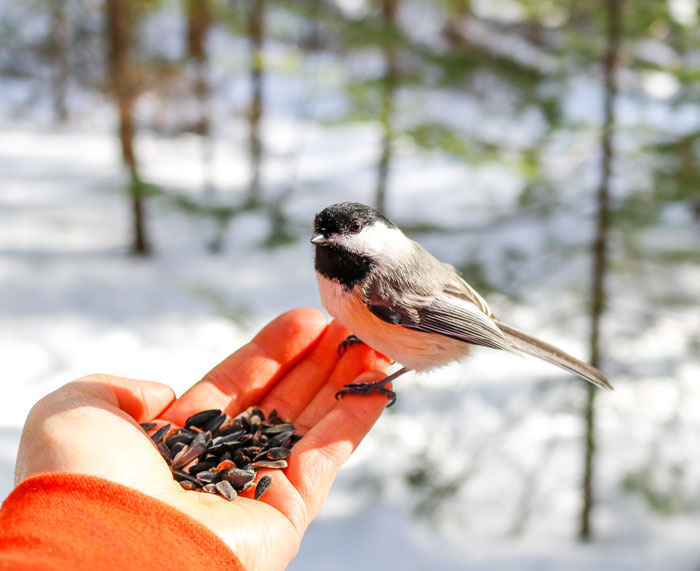
As time goes by and as they get to be completely comfortable with you, they may choose to perch elsewhere on your body. My daily experiences with my birds include them perching anywhere on my body. For example, I have had birds perching everywhere from the top of my head to my shoes. I have had three or more black-capped chickadees waiting in line on my arm to get to the food in my hand or the food container. It is normal behavior for chickadees to grab a seed fly off and consume it elsewhere.
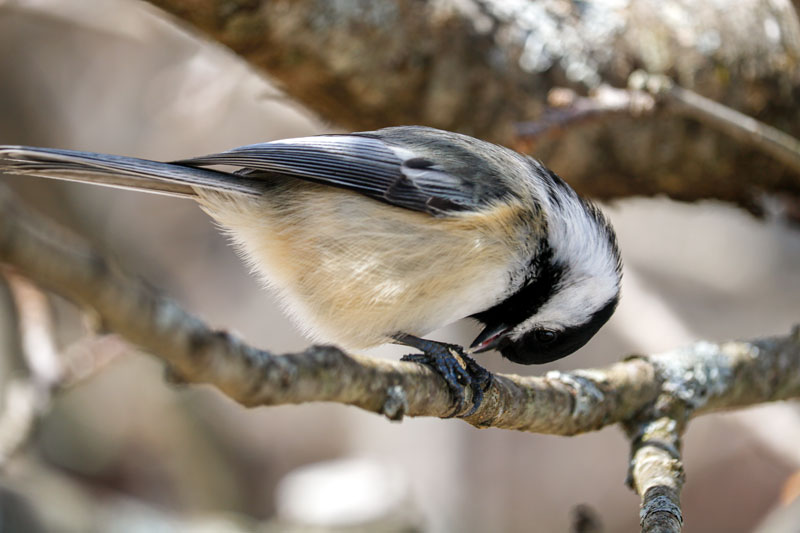
I have had a few chickadees so comfortable with my way of feeding, that they stay and break sunflower seeds open right on the edge of the container. I have one in particular that keeps its back to me, while it eats. Now that is trust. Also, if I hide any of the real tasty treats in my hands for a later time, they will gently peck at my fingers to get to the goodies. Nothing gets past these guys. Once, I even had a brazen chickadee go into my jacket pocket for food! Apparently, nothing is off-limits anymore.
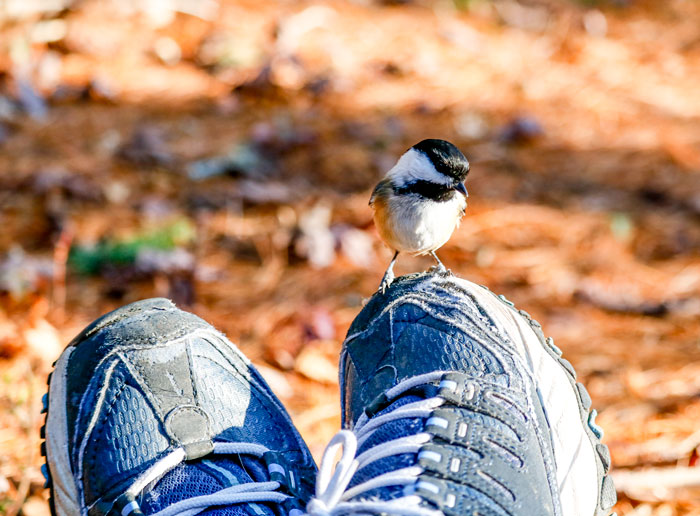
Avoid Any Sudden Movements
Make sure to behave consistently around your birds, which means no sudden movements or noises. Remember, it is their nature to flee for their self-preservation.
Most of All, Be Patient with Your New Friends
Building trust takes time with any relationship, so don’t treat the birds any differently. Be patient and be kind to your new little friends and your dedication will pay off!
I look forward to every day with my birds and I think this experience is a nice way to start the morning and helps to get me centered for my day ahead. When we have visitors come over, they now, too, are feeding the birds. It is nice to see how happy it makes people and it is nice to know the birds are enjoying their treats as well. I often joke that we should charge admission for feeding the birds. I think everyone would get a real kick out of it. Of course, the cost of admission would only be to bring really good bird food!
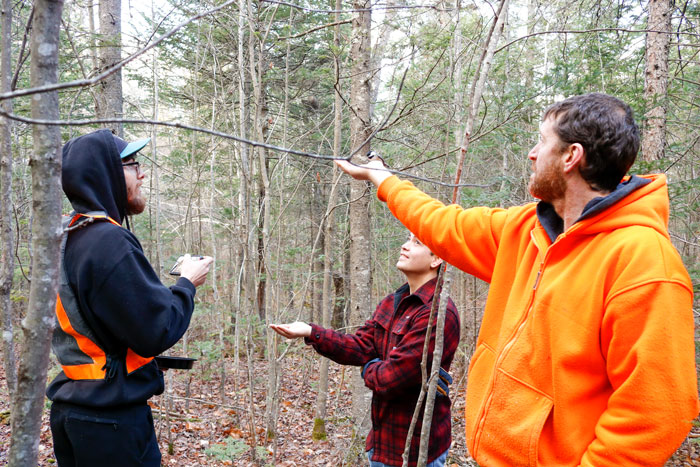
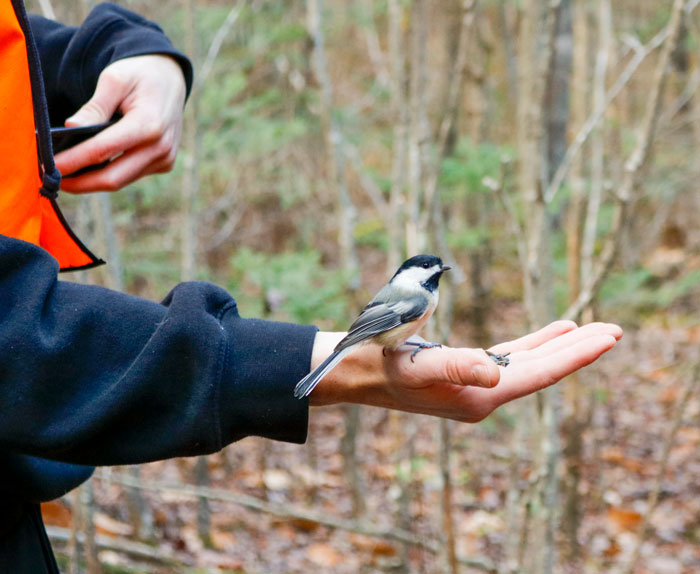
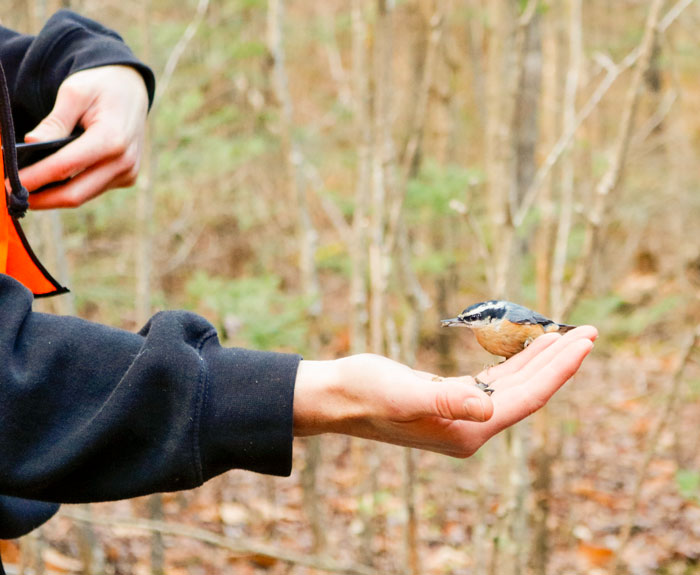
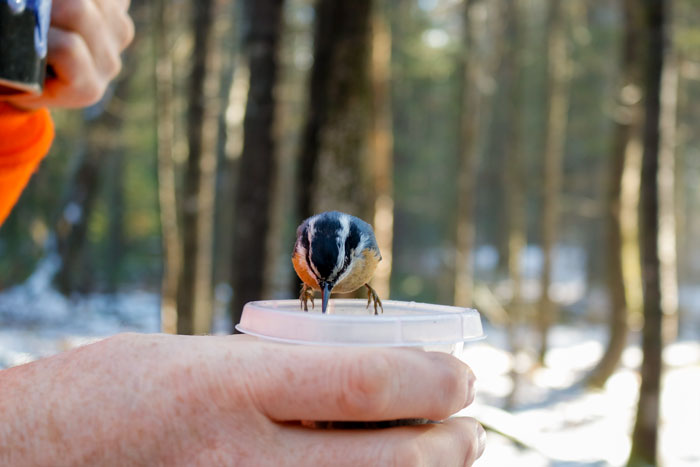
Being that my American red squirrel buddies didn’t want to be excluded, I now have a squirrel enjoying my bringing bird food into the woods, too. He comes to visit us in the same area of the woods every morning. Well, word has spread and now two squirrels are joining in on the fun. I put the container on the ground for everyone to enjoy. I put food in the top and bottom of the container because the birds prefer not to share with the squirrels. I think this helps the birds that are still too shy to eat from my hand but will eat from the container. With my hands being free, I can comfortably hand-feed some of the other birds, too, and then everyone gets something to eat.
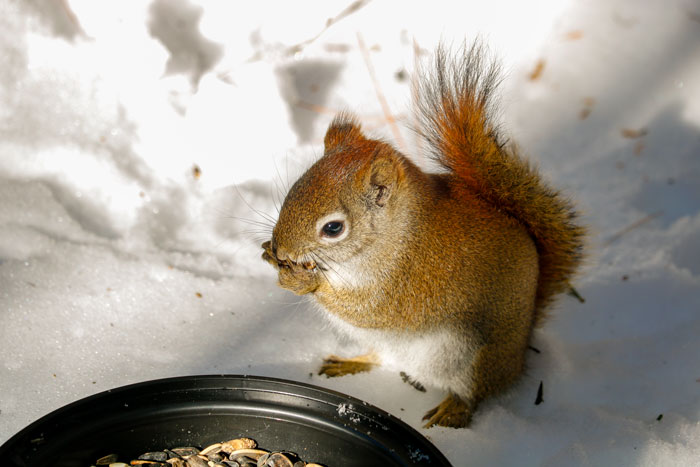
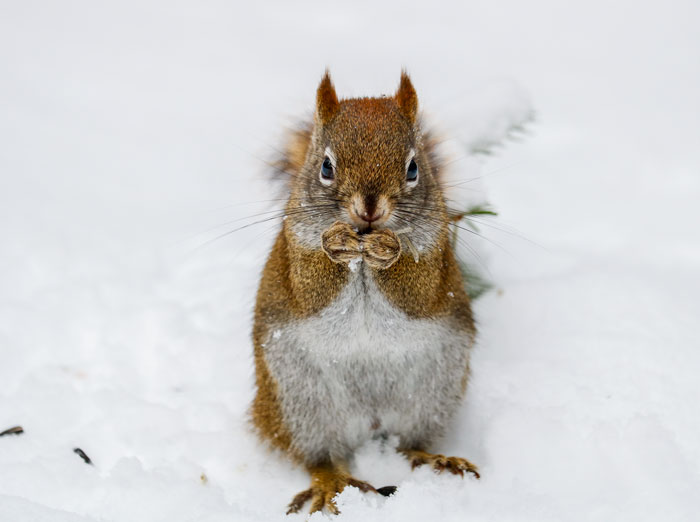
As a side note, to decrease any disease transmission, I wash my hands well afterward. Just like my bird feeders, I also wash my feeding containers at least once a week with white vinegar and hot water to minimize any problems. From the habits of my vet tech days, I make an effort to make sure the birds are looking healthy. For example, their eyes look bright and clear and their feathers, legs, and toes look great as well. Also, I make sure to never wear any hand creams or perfume before setting out to feed the birds as I’m sure it can’t be good for their health.
This has been such a wonderful experience and I’m particularly fond of my male red-breasted nuthatch. Just the other day, after all of the other birds, had left, he stayed behind and actually stayed on my hand and ate a few seeds and nuts. Usually, the nuthatches will take a seed or nut and take it to store in the crevices of the bark of the trees. After he ate his food, he simply stayed on my hand and he then proceeded to give me several eye kisses, and of course, I reciprocated. This guy is so sweet sometimes and he just melts my heart.
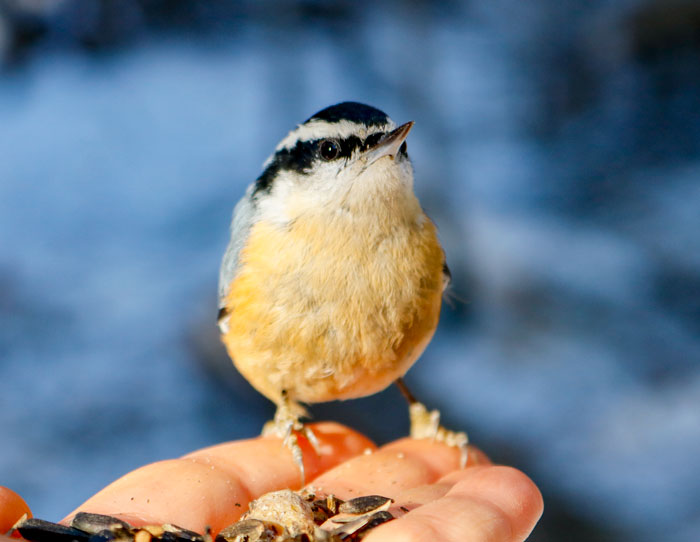
I may be competing for his attention though. I noticed the male has been a bit more peculiar than usual and now I know why. Yesterday, a new female red-breasted nuthatch started feeding from my hand. They were quite vocal with each other and developed some sort of interesting relationship. I think she may be even quirkier than he is. She acts as though the food I am offering is just for her. She chased the male nuthatch away as well as several of the chickadees. She also likes to use the top of my head as a perch as she talks to the other birds. It will be interesting getting to know her better soon. I look forward to even more comical occurrences with my regular birds as well as new visitors in the future.

It is such an incredible honor to have the trust of a wild bird as well as true a gift from nature. I hope you enjoyed my stories as well as these tips. You will be well on your way to enjoying your birds even more and you will have new avian friends feeding from your hands in no time, too.

I would love to hear from you if you have any questions or comments. Thank you for reading.
Resource used for this post:
audubon.org
Leave a Reply